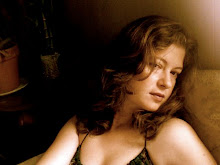Big, bold and brash photos capture bohemian feel
By Doug MacCash Art critic
Times-Picayune 12/15/00
In 1930s Paris, author Henry Miller wandered the streets begging for change to buy bottles of wine, which he shared with the aspiring artists, musicians and street performers who inhabited the same cold, bleak bohemian tenements as he. He glorified those bitter days in prose, establishing the romantic ideals of unfettered artistic liberty that inspired Kerouac, Dylan and every generation of young artists that has followed.
"Fantastic Stories," Michelle Elmore's exhibit of photographs at Jonathan Ferrara Gallery, which was inspired by Miller's 1948 memoir "The Smile at the Foot of the Ladder," buzzes with the sort of brash, youthful, no-holds-barred attitude that marked Miller's early career.
The first room of the gallery contains huge, 4 x 5 foot color prints: theatrical shots that look like posters for foreign films, minus the title and text. "Without You" is an extreme close-up of a young woman in clown make-up, lying in the grass. "Untitled" is another close-up of a clown's face (actually artist Robert Guthrie) twisted into a sour grimace. "Shane's Kitchen" is a low-angle shot of a nude young woman toying with a marionette in a dimly lit room. And "smoke" is the paint- splotched hand of an artist, holding a smoldering cigarette.
Those and several others are clear illustrations of the romantic Miller milieu. A few shots, however, are harder to equate with the theme. "So You Won't Forget Me" is a portrait of a young man with a mottled sheet of kelp stretched over his face like a mask. "OM" is a nude pregnant woman, partially disfigured by the scar of a burn, crouching in a flower garden. "Angels and Cold Water" shows a woman in a winged costume posing on a rock in a creek. Though these may not specifically link to the classic bohemian lifestyle, they somehow fit.
The sheer size of these photos telegraphs Elmore's bravado. Visually, each is an enthusiastic shout, an outpouring of artistic joie de vivre. Though it's hard not to be caught up in the exuberance, in truth only a few of the huge images deserve the large-scale treatment.
"Lady Luck -- Blind" is a wonderful self-portrait of Elmore in a pink prom dress, shooting dice. The amazing part of the shot is that through exquisite timing (or the luck mentioned in the title) Elmore managed to catch the flying dice in clear focus, while the rest of the shot is a haze. Outstanding.
Another stand-out is "Brian," a young man coated in red paint, holding a sliced watermelon. Notice how the cracking body make-up echoes the white marbling in the watermelon, which echoes the color of the dirty dashboard, which echoes the red farm building in the background. Excellent.
By Doug MacCash Art critic
Times-Picayune 12/15/00
In 1930s Paris, author Henry Miller wandered the streets begging for change to buy bottles of wine, which he shared with the aspiring artists, musicians and street performers who inhabited the same cold, bleak bohemian tenements as he. He glorified those bitter days in prose, establishing the romantic ideals of unfettered artistic liberty that inspired Kerouac, Dylan and every generation of young artists that has followed.
"Fantastic Stories," Michelle Elmore's exhibit of photographs at Jonathan Ferrara Gallery, which was inspired by Miller's 1948 memoir "The Smile at the Foot of the Ladder," buzzes with the sort of brash, youthful, no-holds-barred attitude that marked Miller's early career.
The first room of the gallery contains huge, 4 x 5 foot color prints: theatrical shots that look like posters for foreign films, minus the title and text. "Without You" is an extreme close-up of a young woman in clown make-up, lying in the grass. "Untitled" is another close-up of a clown's face (actually artist Robert Guthrie) twisted into a sour grimace. "Shane's Kitchen" is a low-angle shot of a nude young woman toying with a marionette in a dimly lit room. And "smoke" is the paint- splotched hand of an artist, holding a smoldering cigarette.
Those and several others are clear illustrations of the romantic Miller milieu. A few shots, however, are harder to equate with the theme. "So You Won't Forget Me" is a portrait of a young man with a mottled sheet of kelp stretched over his face like a mask. "OM" is a nude pregnant woman, partially disfigured by the scar of a burn, crouching in a flower garden. "Angels and Cold Water" shows a woman in a winged costume posing on a rock in a creek. Though these may not specifically link to the classic bohemian lifestyle, they somehow fit.
The sheer size of these photos telegraphs Elmore's bravado. Visually, each is an enthusiastic shout, an outpouring of artistic joie de vivre. Though it's hard not to be caught up in the exuberance, in truth only a few of the huge images deserve the large-scale treatment.
"Lady Luck -- Blind" is a wonderful self-portrait of Elmore in a pink prom dress, shooting dice. The amazing part of the shot is that through exquisite timing (or the luck mentioned in the title) Elmore managed to catch the flying dice in clear focus, while the rest of the shot is a haze. Outstanding.
Another stand-out is "Brian," a young man coated in red paint, holding a sliced watermelon. Notice how the cracking body make-up echoes the white marbling in the watermelon, which echoes the color of the dirty dashboard, which echoes the red farm building in the background. Excellent.
